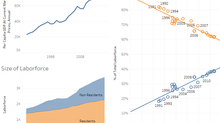Singapore in Numbers - Employment & Unemployment
In our previous segment, we have established that Singapore’s economic growth since independence is very impressive, particularly, in the fact that this was accomplished in 50 years, barely a generation. This is most evident in Singapore’s GDP per capita.
Singapore’s labour force

One of the key driving forces behind the growth is the Singapore labour force. As at 2016, there are 3.67 million people in the Singapore labour force. But a very sizeable portion of Singapore’s labour force are non-residents (38.5%); which has more than doubled in the last 25 years
Non-resident labour made up only 18% of the labour force in 1991
[endif]--Non-resident labour grew by more than 4.7 times in absolute numbers over the same period
The proportion of non-residents in the Labour force rose with the growth in GDP per capita ![endif]--
When faced with the above trend, it is not hard to see why this continues to remain a major cause for concern among policy makers as well as the man on the street.
Can/should Singapore continue to depend so much on non-resident labour to support the economy?
What are the risks and opportunities of keeping the current practice? What alternatives are there?
What is the real and perceived impact on the resident labour force?

Unemployment
Another unique defining feature of the Singapore economy is the consistently low unemployment rate. Barring specific economic events (financial crises), Singapore has remained at full employment (unemployment rate[1] below 4%). As at 2016, Singapore’s unemployment rate stands at 2.8%; but that may not be the whole story…
The Singapore Ministry of Manpower defines a person as unemployed, if they are not working, but are actively looking and available for work. But unemployment takes on a different meaning for residents versus non-residents.
By definition, non-residents in the labour force are in Singapore for work; in which case, they are largely fully employed. In the event they lose their jobs, many must leave Singapore (no job = no work pass) unless they can find another job. Residents, on the other hand, remain in Singapore regardless. As at 2016, the resident unemployment rate stands at 4.1%. Key highlights form the data:
The high proportion of non-residents in the labour force is a contributing factor to the low total unemployment rates
The incidence of unemployment, particularly for residents, is higher than what the total unemployment rates suggests; that said, at 4.1%[1], it is still very close to full employment /
In recent years, this rose as high as 6% corresponding to specific economic events (Asian Financial Crisis 1998, Collapse of global IT sector 2001, SARS 2003, Global Financial Crisis 2008). Prior to 1997-8, the resident unemployment rate was relatively stable at between 2.5-2.8% even as the non-residents accounted for over 30% of the Labour Force. But since then, resident unemployment rates have seen a marked increase to about 4% and it looks like this will be the new norm. The most significant change to Singapore economic strategy at that time, was the liberalization of the insurance and securities industries and progressive steps were taken to open up the domestic banking industry to foreign competition[2]; which could be one of the contributing factors to the higher resident unemployment rates.
Key considerations
Singapore has been highly reliant on foreign labour to drive its economy. However, when non-residents make up over 38% of the labour force, it may not be economically efficient, socially desirable nor politically sustainable to continue with the practice. Which has already prompted policy changes to manage the growth of non-resident labour in Singapore.
As companies restructure in response to policy changes and market externalities, unemployment rates may continue to fluctuate. Current data suggest that the impact on the resident labour force is still manageable (4.1%); and steps have already been taken by policy makers to improve unemployed residents' career mobility (Skillsfuture, changes in employment laws, job fairs, job banks etc.). For now, residents remain largely at full employment.
But behind the unemployment numbers, each case is an individual who could have a family to feed, children to put through school and debts to service. And in a city/country which is consistently ranked among the most expensive cities by cost of living, few individuals can afford to remain unemployed in Singapore for long. Bills have to be paid, whether you have a job or not. The resident unemployment rate will bear more scrutiny especially as Singapore’s economy continues to evolve.
[1] - This report is based on Singstat data, but MOM has a different unemployment rate for 2016
[2] - An Economic History of Singapore: 1965-2065" - Keynote Address by Mr Ravi Menon, Managing Director, Monetary Authority of Singapore, at the Singapore Economic Review Conference 2015 on 5 August 2015
![endif]--
























